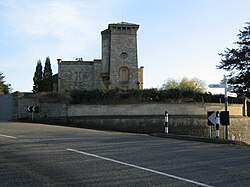Difference between revisions of "Kelston"
(Created page with "{{Infobox town |name=Kelston |county=Somerset |picture=Kelston church.jpg |picture caption=The Tower House |os grid ref=ST705675 |latitude=51.402 |longitude=-2.4318 |populatio...") |
(→History) |
||
| Line 23: | Line 23: | ||
==History== | ==History== | ||
| − | The name of the village was recorded as ''Calveston'' in 1178. The familiar ''-ton'' ending indicates farmstead or estate. The first part of the name may mean "belonging to Celf or Caelf".<ref>{{ | + | The name of the village was recorded as ''Calveston'' in 1178. The familiar ''-ton'' ending indicates farmstead or estate. The first part of the name may mean "belonging to Celf or Caelf".<ref>{{Placenames Mills}}</ref> However, it may mean a place where calves were reared.<ref>Davey, Cyril, West Country Place Names and What They Mean, Abson, 1983</ref> |
It is the site of the Elizabethan Kelston Manor House, built by the Harington family and demolished in the 18th century. | It is the site of the Elizabethan Kelston Manor House, built by the Harington family and demolished in the 18th century. | ||
Latest revision as of 21:23, 29 March 2020
| Kelston | |
| Somerset | |
|---|---|
 The Tower House | |
| Location | |
| Grid reference: | ST705675 |
| Location: | 51°24’7"N, 2°25’54"W |
| Data | |
| Population: | 248 (2011) |
| Post town: | Bath |
| Postcode: | BA1 |
| Local Government | |
| Council: | Bath & NE Somerset |
| Parliamentary constituency: |
North East Somerset |
Kelston is a small village in Somerset, four miles north-west of Bath and eight miles east of Bristol, on the A431 road. It is situated just north of the River Avon, close to the Kelston and Saltford locks. The parish has a population of 248.
It is within the county's Bath Forum Hundred.
Parish church
The parish, the Church of St Nicholas, dates from the 13th and 14th century although it was heavily restored and rebuilt in 1860 by Benjamin Ferrey.[1]
History
The name of the village was recorded as Calveston in 1178. The familiar -ton ending indicates farmstead or estate. The first part of the name may mean "belonging to Celf or Caelf".[2] However, it may mean a place where calves were reared.[3]
It is the site of the Elizabethan Kelston Manor House, built by the Harington family and demolished in the 18th century.
Kelston railway station was on the now-closed Midland Railway line between Bath Green Park station and Mangotsfield. The station was three-quarters of a mile across the fields from the village, near the bridge that carried the line and a footpath across the Avon to Saltford. It was known in railway timetables as "Kelston (for Saltford)". It opened four months after the railway line opened in 1869 and closed at the end of 1948. Trains continued to use the line until its closure in 1966 under the Beeching Axe. The track is now used for the Bristol & Bath Railway Path.
Landmarks
The churchyard at Kelston is the burial place of Sir John Harington, author, epigramist and inventor of the flush toilet (water closet), the first model of which he installed at Richmond Palace for his godmother, Queen Elizabeth I.
Kelston Park was built around the 1760s by John Wood, the Younger, for Sir Caesar Hawkins, who was the physician to the King. It is a Grade II* listed building.[4]
Kelston also has an 18th-century Village lock-up.[5]
See also
| ("Wikimedia Commons" has material about Kelston) |
References
- ↑ National Heritage List 1214866: St Nicholas' Church
- ↑ Mills, Anthony David: 'A Dictionary of British Place-Names' (Oxford University Press, 2003) ISBN 978-0-19-852758-9
- ↑ Davey, Cyril, West Country Place Names and What They Mean, Abson, 1983
- ↑ National Heritage List 1215080: Kelston Park and adjoining Service Wing and Coach-house and South Retaining Wall
- ↑ National Heritage List 1214721: Village Lock-up
